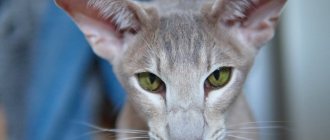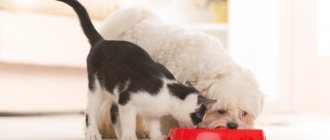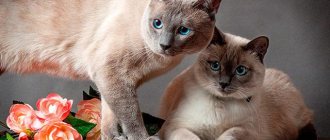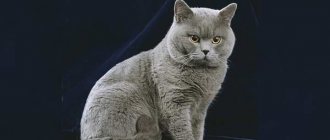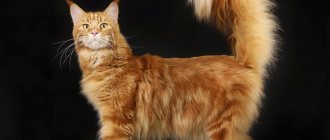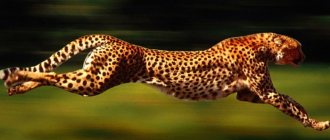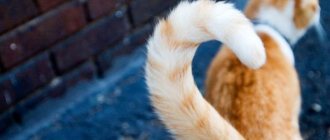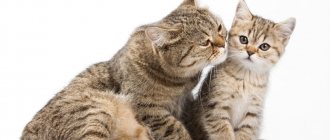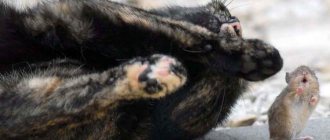The Bengal cat is a graceful animal that has a bright, golden color with black spots, reminiscent of the fur of a leopard. She is considered one of the most beautiful, rare and expensive cat breeds, which inherited the independent character from the wild ancestor and the affection and loyalty from the domestic pet.
The cost of a kitten can vary from 40 to 80 thousand rubles. Such cats have a keen sense of smell, expressive eyes, a flexible muscular body, strong paws, and the independent character of an excellent hunter. With proper upbringing, they become loyal and affectionate friends.
Description of the breed
There are many different breeds of pets, in particular cats, each of which has different habits, external characteristics, etc. Therefore, when buying a kitten, you should pay attention to the appearance and character of the pet. The Bengal cat (or bengal) is the name of a breed of the cat family. The breed appeared in the USA as a result of crossing an Asian leopard cat and a black cat. Therefore, Bengals combine the physical strength and strength of their wild ancestor (leopard) and the gentle nature of a domestic pet.
The standard of the Bengal breed is clearly stated in the classification of feline species. Since 1991, the breed has been officially recognized. This was done so that owners of domestic cats could participate in competitions and exhibitions. Pets are of average size: their height ranges from 25 to 32 cm (this is the height of an adult pet, which is measured at the withers). An adult animal can weigh about 4-8 kg (cats - 4-6 kg, cats - 7-8 kg).
Pets have an elongated muscular body and strong legs (the front ones are slightly shorter than the back ones). The tail is of medium length, rounded at the end. The animal's ears are short, slightly rounded, and widely spaced. Cats are dexterous and active, have a developed hunting instinct (they easily catch small rodents and birds), and are independent in nature.
The color of the animal is a striking feature of this feline representative. There are marbled and spotted cats, similar in color to the fur of a leopard. An important feature of a healthy cat is the shine that can be seen on the coat under the sun's rays. Many owners note that the fur of this animal can bewitch: it is pleasant to stroke the pet for a long time and it is difficult to tear yourself away from it.
Cats of this breed are classified as shorthaired. They have thick, soft fur that shimmers in golden hues in the sun. Short pile is a big plus for owners, because... does not require special care for your pet’s fur, unlike long-haired representatives of the cat family.
With a healthy diet and proper care, a Bengal cat can live from 12 to 15 years. In this case, the pet requires regular examination by a veterinarian as a measure to prevent the development of dangerous diseases.
Pet colors
A striking feature of animals of this breed is their color. The presence of shades from white to dark brown with a pronounced color contrast is acceptable. The most popular colors are merle and spotted. Less common are cats of black or silver tabby, snow, etc. colors.
A cat's diet has a direct impact on the condition of its coat. The fur of a healthy animal shimmers in the sun with golden hues; the fur sheds only during the molting period or during sexual heat. If a cat’s coat does not shine and the hair comes out in clumps, it means that the pet does not have enough vitamins and minerals. You can buy a special medicine (vitamin complex) at a veterinary clinic or consult a specialist about this.
Advantages and disadvantages
When buying an animal, you should pay attention to the pros and cons of the breed in order to have an idea of the character of the future pet. The positive aspects include:
- activity, playfulness of the cat (this is especially important if the family has children who love animals);
- cleanliness (the animal is not afraid of water, loves to swim);
- loyalty and devotion to its owner (the pet cannot be away from the owner for a long time);
- ability to train (if you regularly exercise with a cat, it can learn to carry out simple commands);
- no special requirements for animal care.
The disadvantages include the high cost of a kitten, which can reach up to 70 thousand rubles. and higher. If a future owner acquires a pet with the intention of breeding Bengals, he must remember the purity of the breed (crossbreeding can only be done within a species). Therefore, when buying a kitten, you need to ask the seller for the appropriate certificate.
Kanaani
The Kanaani cat (or Canaani) is a new breed bred by an Israeli resident D. Pollacek, registered in 2000. Several breeds were crossed: Bengal, Libyan steppe, Abyssinian, common domestic and others.
The mixture of Libyan and homemade turned out to be the most successful. The animal has an independent character, distinguished by its love of walks and freedom. But the cat also adapted well to the new environment, was unpretentious in care and undemanding in nutrition. Balanced habits and love for affection do not exclude the fact that she definitely needs a leash on the street, otherwise she will run away.
The Kanaani is a breed with a short, coarse coat that ranges in color from light yellow to brown with contrasting spots. At medium size, large specimens are found.
They are strong, have well-developed muscles, high legs, on which they run quickly. It is necessary to add almond-shaped eyes and tufts on the ears of some individuals. Health is good, you just need to find a common language with your pet in order to live in harmony with it.
Origin history and interesting facts
The Bengal is an artificially bred cat that has its own breed history. Such animals do not exist in nature. In 1961, American cat breeder Jean Mill purchased a wild Bengal kitten from a local market in Bangkok (the fur of these large animals was valuable prey for poachers, so the species was on the verge of extinction). Returning to her homeland, the scientist decided to create a new breed of domestic cat.
As a result of long-term experiments of crossing wild cats and cats (Bengals from India) and domestic cats and cats of different breeds (including Burma and Mau), a large number of interspecific and interbreed representatives of the cat family appeared. The completion of ten years of work was the appearance of the Bengal cat breed, which had the spectacular appearance of a wild graceful animal and the character of a pet.
In 1991, Bengals were recognized as a new breed of domestic cat.
Interesting facts about Bengal cats:
- pets are capable of training and can learn to follow simple commands;
- Animals love water and love to swim and splash around in a bathtub or other container filled with water.
Pets are susceptible to training. They are smart, attentive and quick to learn, and can learn to carry out some of the standard commands that dogs are taught. The Bengal can be walked perfectly on a leash.
You can train your pet starting from three months. If the animal has followed the command correctly, you should reward it with a piece of treat and pet it. The workout should last on average 10-15 minutes, it is recommended to do it no more than twice a week. If your pet is not in the mood to exercise at this time, it is worth postponing the lesson to a later time or rescheduling the training to another day.
Savannah
The largest cat that looks like a leopard is the Savannah. This hybrid has the greatest resemblance to a wild animal. This is a unique and very expensive animal, the cost of an individual is from $4,000.
The breed appeared from crossing a wild serval and an ordinary domestic one; it has a large appearance with long legs, a neck, and huge ears. The official registration of the breed with all its standards in the international cat association occurred in 2011.
The signs observed in habits are as follows.
- Significantly larger than regular cats, Savannah cats are very playful and intelligent.
- They are easy to train, enjoy walking outside on a leash, do not like the cold, but are willing to swim.
- They are easily toilet trained and do not require a strict diet or special care.
- They show affection to their owners and are friends with children and other pets.
Although this is a young breed, not yet fully housetrained. The cat's habits are such that no sudden movements should be made near it, as it will immediately attack an object. In this case, no aggressive anger is observed, only a manifestation of a reflex.
Breed standard, appearance
The appearance of an animal has features that allow us to judge its breed. These include the color of the animal, weight and height and other factors. These features indicate the purity of the breed and are taken into account when participating in competitions. Bengal has the following characteristics:
- the height of an adult animal is 25-32 cm;
- weight - 4-7 kg (males are larger and heavier than females);
- the animal's fur is short, thick and soft to the touch (reminiscent of silk);
- color - bright, spotted-striped, full of color contrasts, reminiscent of the color of a leopard; the color contains shades of white, red and gray, and the spots should be evenly distributed throughout the cat’s body;
- body - dense, strong, muscular;
- paws - strong, powerful, round; the front ones are slightly shorter than the rear ones;
- tail - dense, not fluffy, of medium length; characteristic spots and rings should be present throughout the tail;
- the head is wedge-shaped with a massive chin, like a “tiger’s” mouth (square; this can be seen when the cat yawns, meows or growls);
- ears - short, set high, slightly rounded, with pointed tips, widely spaced;
- nose - large and wide, slightly curved;
- cheeks - have large mustache pads;
- eyes are large, expressive, almond-shaped, their color can be green or golden.
An adult is a medium-sized animal with a bright, unusual color and standard dimensions. If the nature of the drawing does not match the description of the breed, the pet may be disqualified from competitions.
How much does a leopard kitten cost?
Bengal kittens cost from 30 to 100 thousand rubles, depending on the color and strength of the phenotype of a particular animal. Some sellers divide them into classes based on genetic strength.
Ashera prices start at $22,000. Royal ones cost $125,000 and appear no more than 4 times a year.
a Savannah kitten anywhere for less than $4,000.
The cost of the Serengetti is low due to the fact that the breed does not have a classical standard and strict requirements for the characteristics of animals. The average price is 35,000 rubles, which
The cost of a Kanaani kitten is from 90,000 rubles.
The price of the Arabian Mau starts at 40,000 rubles.
The most inexpensive among leopard cats is the Asian tabby. Its average price is $1,000.
Bengal character
Bengals are strong, agile and independent cats that have a special character and habits. They owe these traits to their ancestors. Bengals are excellent hunters: they are brave and cunning, capable of catching mice (the cat only likes to catch prey, they rarely eat it). Cats are able to get along with other animals (dogs and cats) living in the house. The presence of other pets should not affect the lack of attention to her person. The only exceptions are birds and rodents (the hunting instinct may take over).
Bengals need constant attention and communication with their owner: with a lack of affection, they become wild and uncontrollable. Therefore, it is necessary to often hold a kitten in your arms from an early age and continue such communication with an adult cat. In this case, the Bengal beauty will become a faithful, devoted and affectionate friend.
It is difficult for a pet to be separated from its owner. If the owner of the animal must leave urgently and for a long time, it is better to leave the cat with friends or loved ones who have met the animal before. One of the forms of manifestation of sadness due to parting with the owner and disagreement with the situation is refusal to eat.
Pets always strive to be close to their owner, but they cannot sit in one place for a long time. Animals are active, love to play, run, study and explore new things. Therefore, they will willingly be in the same room with their owner and will not sit on their hands for a long time.
Such a cat is confident in itself, shows curiosity and a desire to learn everything new. She is faithful to her owner, affectionate with him and grateful for his care. Bengals ask to be held only when they themselves want it.
The Bengal breed is distinguished by its intelligence. Training allows the pet to free itself from excess energy and please its owners. They are able to carry out simple commands that are taught to dogs (“fetch”, “sit”, “stay”, etc.).
Cats of this breed, unlike their relatives, love water and enjoy bathing. If the owner leaves a filling bathtub, a basin of water or another container unattended, the cat may climb in and splash around.
Thus, a brief description of the animal is as follows:
- they are smart, independent;
- affectionate, devoted (with proper upbringing);
- excellent hunters, energetic and dexterous;
- curious people who want to explore new things;
- They are easy to train and are not afraid of water procedures.
A properly raised cat will be affectionate, devoted and grateful to its owner for his care and attention.
Asian tabby
This breed is of British origin, bred in the 1980s. To obtain it, a Burmese cat was crossed with a Persian chinchilla. The result is a short-haired animal, strong, with a good physique.
On her neck there is a spot - a necklace, and her eyes and nose with mouth are also outlined. The tail is tapered, with ring-shaped spots.
Painting comes with 4 types of patterns:
- spotted;
- marble (with stripes and stains);
- brindle;
- ticked (with a pattern on the face and striped hairs on the body).
Colors range from blue to cream and chocolate. The ears are erect, the eyes are almond-shaped, the irises are golden, and there are cheekbones. The character is friendly, gentle, communicates with people and other inhabitants of the house.
Leopard-colored cats are a mixture of various breeds, including wild ones. The most important thing in communicating with them is to try to find mutual understanding. A close study of your pet will help you find a common language and create comfort for everyone.
Features of keeping a pet of the Bengal breed
Bengal cat breeds are often adopted by families with small children. This is a suitable option because... the pet receives enough attention and care from the child: its energy will be directed to bringing joy to the children. Children love to play with animals, so the Bengals' needs remain satisfied and they delight their owners with interesting games and various tricks.
Pets are active, energetic and love to frolic and play. Therefore, it is important for them to have personal space so that they can find something to do while the owner cannot give them attention. In pet stores you can buy hanging ladders, kitten houses with climbing posts of different heights, etc. It is advisable to purchase a scratching post separately so that your pet understands where she can sharpen her claws and does not damage the furniture.
Bengals have a keen sense of smell, so there should be no strong or irritating odors in the house where the cat will live. This also applies to strong-smelling detergents (for cleaning carpets, mopping floors, etc.). A strong, irritating odor can have a detrimental effect on the health and general condition of your pet.
Bengals are clean animals, so they quickly get used to the tray. The owner will have to regularly clean the cat's litter box, because... These pets do not like dirt, otherwise the cat will not go to its toilet. It is recommended to purchase a tray that has high sides, otherwise all the litter and contents of the cat litter may end up on the floor. Do not wash the litter box using strong-smelling detergents, otherwise the cat may refuse to go there.
Pet food
The nutrition of Bengal cats is an important point: the health and appearance of the pet will depend on it. Veterinarians say that these cats have a sensitive digestive system, so the food they eat must be carefully selected.
The choice of diet is determined by the capabilities of the owner. The owner can buy a special balanced food (it is available in dry form or as jelly pieces in sauce). When purchasing, you should pay attention to who can eat this food (each label indicates the age of the animal for which the product is intended).
The most popular foods are WildCat Etosha (Germany), Purina Pro Plan, Royal Canin Bengal Adult (France). You should not give your animal cheap food. To make sure that the food is appropriate, you can give your pet a small portion and see how his body reacts. If the animal feels well and no significant changes have occurred (the animal is active, mobile, no allergic reaction is observed), you can continue to give the animal this food.
In some cases, individual intolerance to the product may occur. If the owner is in doubt about what is best to choose, you can consult a veterinarian.
The second option is to independently compose the animal’s diet. When developing a diet, you need to take into account that the pet needs to eat meat (heat-processed, not raw), fiber, carbohydrates, vitamins and minerals, etc. If it is difficult for the owner to independently create a diet for his pet, you can consult a veterinarian. It is unacceptable to mix food from different manufacturers or dry food with natural food in one bowl.
Your cat should always have a bowl of clean drinking water. It is unacceptable to feed your cat raw meat, because... this can provoke the appearance of worms and other parasites in the pet’s body, cause poisoning, etc.
Thus, the owner must answer the question of what to feed a Bengal cat by studying the preferences and condition of his pet. This can be a ready-made balanced food purchased in special animal care stores. Or the owner himself will create a diet and give his pet natural food.
Appearance care
An animal's appearance is determined by its diet. If a cat receives all the necessary vitamins and minerals, it will not have health problems, in particular with its fur (the fur will retain its shine and will not fall out).
Bengals do not require special care. They need to trim their nails regularly (it is advisable to have a scratching post at home in addition to this) and comb their fur at least once a month (it is recommended to use a brush with natural bristles for this).
It is not advisable to bathe a cat frequently (water procedures are acceptable once every six months or in case of severe contamination, if the owner takes the pet for a walk outside).
Thus, Bengals do not cause problems as pets. Caring for them involves following standard rules for caring for pets living at home.
Arabian Mau
It also has spots, and the coat itself has no undercoat. Color ranges from white with black spots to black without spots. The main color of the breed is brown or gray with patterns.
This cat cannot claim the title and is only temporarily recognized, but in 2008 it was standardized. For the Middle East, this animal is native. Characteristics: Large size, muscular, high legs, tapered tail. The paws are rounded, and large ears are located above the head. Males are larger than females, weighing up to 8 kg.
The Arabian Mau has oval eyes that match the color of its coat. Friendly character: accompanies owners, plays with children. Care - weekly brushing, ear cleaning, walks.
The breed standards are as follows:
- A muscular body with long legs cannot be called very slender.
- The coat is adjacent to the body, hard, and in adult specimens silkiness is excluded.
- The coloring is very diverse: black spots on a white background and white on black, tabby (pattern on the body), gray and brown tones.
Diseases and life expectancy
The key to a cat’s health is a properly selected, balanced diet and regular preventive examinations at a veterinary clinic. Cats of this breed are distinguished by good health, a strong and elastic body, so the owners should not have any problems. Exceptions include inflammatory bowel disease, cardiomyopathy, and urological problems. The cat has a sensitive digestive system, which must be taken into account when preparing its diet.
As preventive measures, it is necessary to regularly give your cat the necessary vaccinations and give medications against possible parasites (medicine for worms and fleas). It is advisable to purchase a cat collar that provides protection against insects (fleas, ticks, etc.).
Breeding Bengal animals is a labor-intensive task and requires a lot of strength and patience. Kittens are ready for mating at the age of 8-9 months. At this time, they become agitated and moody. The choice of partner depends on the pet's subtype. It is unacceptable to breed the Bengal breed with outbred animals: the kittens will not inherit the genes of the breed.
If the owner does not intend to breed his pet to give birth to kittens (i.e. pregnancy of a Bengal cat is undesirable for him), it is better to castrate or sterilize the animal. This measure will help avoid the development of hormonal diseases in the cat. Special products that are sold in pharmacies to suppress the sexual instinct have a detrimental effect on the health of the cat and can cause the death of the animal.
Cats that have been fed properly throughout their lives and received the necessary vaccinations on time can live quite a long time (12-15 years).
Price
Shiny cats are expensive. This can be explained simply - the breed is exotic, it has not received much distribution. Nurseries engaged in its breeding are mainly located in the USA. And there are not many of them.
It is in this country that you can buy a pure breed kitten. Californians are also bred by some breeders in Europe.
Kittens must be booked in advance, after checking the reliability of the seller and discussing all the terms of purchase. The animal is handed over to the new owner along with the birth certificate and veterinary passport. The approximate purchase amount will be about 2 thousand dollars . Boys cost less than girls (on average about 1.5 thousand). Some nurseries provide customers with an escort service.
Possible problems
As already mentioned in the previous paragraph, adult cats get along well with dogs or felines of other breeds, but in no case with rodents and birds.
It is better not to leave children under 3 years old alone with a Bengal. Cats are quite affectionate and intelligent, but they will not tolerate rude treatment.
